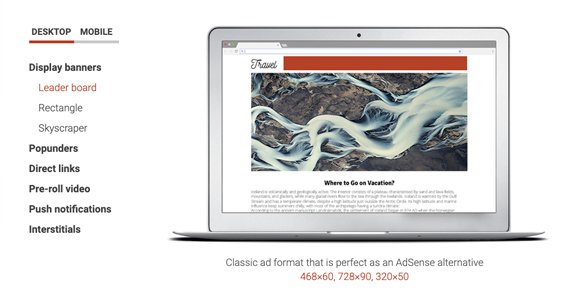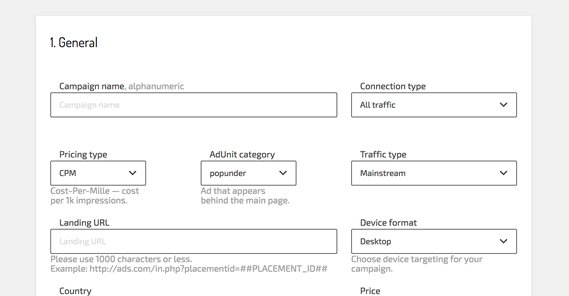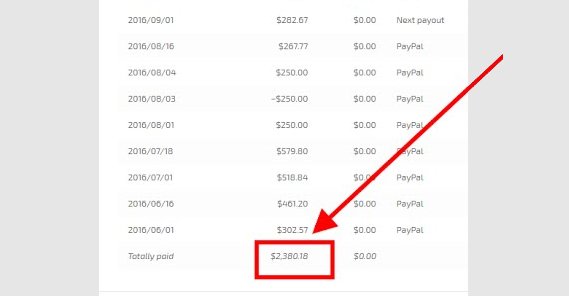Review of Adsterra: How Much Can You Earn With Their Ads?

Adsterra is an advertising network that can be quite valuable for both publishers and advertisers. I’m going to look at it primarily from the publisher point of view today, but keep in mind that a lot of what I mention will be relevant to both sides of the coin. After all, advertisers only get value if the publisher network is good, and publishers only get value if the advertisers are effective.
We’ve mentioned Adsterra before in posts like this list of ad networks with no minimum traffic requirements, and this post about ad networks ranked by cost per conversion. If you want to read a brief blurb about the network, those are two good sources.
About Adsterra
You can visit the Adsterra site here if you would like to explore for yourself, sign up for either side of the platform, or simply follow along as I discuss them.
Adsterra was founded in 2013 in Scotland and has been expanding globally ever since. They serve tens of billions of impressions every month, with geo-targeted advertising. They have well over 8,000 publishers in their network spread throughout the globe, and they’ve been expanding each year.
The network offers cost per action, cost per click, and cost per view advertising options, so publishers can get paid in pretty much any way they want. This is valuable, because it means you can decide which type of ads to use based on your traffic and your typical use patterns. If you have a highly engaged audience that frequently clicks links and ads, CPC or CPA ads can be much better. If your audience is larger but less engaged, you can still monetize them well with CPM ads.
They offer a variety of different ad formats in varying sizes.
- Leaderboard display banners in 468×60, 728×90, and 320×50.
- Rectangle display ads in 300×250 and 800×440.
- Skyscraper vertical display banners in 160×300 or 160×600.
- Pop-under ads that open in new tabs or new windows without stealing focus.
- Direct link ads that show up in text and act like normal links.
- Pre-roll video ads to display before embedded videos on a publisher site.
- Push notification ads, available for both desktop and mobile platforms.
- Interstitial ads that pop over the screen, similar to timed pop-over lightbox ads.
All ad formats are available for both desktop and mobile.
Many people seem to like their pop-under ads, since they are minimally intrusive, and their network demands a certain level of quality, so those ads tend to be valuable rather than spam. I also recommend trying out the push notification ads, the interstitial ads, and the video ads. Video ads tend to have high engagement, push notification ads can work very well for certain segments of users, and interstitials are highly visible.
Adsterra pop-under ads are highly recommended because they are the first and primary offering from the network. It’s what they specialize in, it’s what they’ve spent the most time optimizing, and it’s what their account managers are best at.
Adsterra has two types of accounts you can run. You can engage in their managed platform, where their experienced account managers take over and control your advertising to gain maximal value out of your ads. This applies primarily to the advertiser end of the board; publishers don’t typically need hand-holding and won’t want to give out site editing control to someone who isn’t part of their organization.
At the same time, Adsterra operates a self-service platform where advertisers can browse and buy advertising directly, managing it all themselves. This accesses the same network and has all of the same options as the managed platform, it simply doesn’t have the experienced managers on hand to handle tricky situations or apply their knowledge of the network directly.
One thing I can’t do for you is tell you what your ad rates will be. Adsterra does not maintain a list of public rates; rather, their rates depend on the niche, quality, and location of your site, your type of traffic, and the advertisers interested in your positions.
Now, what about those requirements? Here’s what Adsterra has:
- Publishers must have at least 5,000 impressions per month to be able to use pop-unders.
- Publishers must have at least 50,000 impressions per month to be able to use display banners.
- Publishers cannot be in an adult or illegal content niche.
Of course, referring fake traffic, fraudulent traffic, or traffic from exchanges will get your account suspended and your domain and/or personal information blacklisted from using their network. I don’t know what their process is for appealing this ban, but I would assume it’s difficult.
The Benefits of Adsterra
Adsterra has a lot going for it. It’s a good, solid network that has worked to minimize a lot of the low quality advertisers and publishers that plague many other networks. As such, it’s generally a great option for people who meet their requirements.
Adsterra’s focus on pop-under advertising is by far their biggest strength. My recommendation is to use them as a secondary advertising network. They may offer a bunch of different ad formats, but they’ve put the most work into their pop-under tech, and it’s what most advertisers are going to look for. It’s sort of a self-fulfilling prophecy; they have a reputation for one type of ad, thus the people who sign up are looking for that type of ad, and their other offerings fall by the wayside.
So, my advice is to use Adsterra for their pop-unders, while using other specialized ad networks for your other ad formats. Using two networks who each have specialties works better than using one that does each format in a half-assed way. Not that I’m accusing Adsterra of half-assing anything; they’re quite good across the board. Really, it’s up to you to test which formats work best for your site.
The second biggest benefit Adsterra has going for it is their account managers. Publishers get a personal manager, and advertisers can opt for the self-service platform or to use an account manager. When an account manager is involved, the quality level of ad implementation goes up, because of their knowledge of the network and everything involved.
Adsterra boasts a 100% fill rate with competitive CPM on their ads. I don’t know that they can guarantee 100% fill or if they cherry-picked the data they used to back it up, but their fill rates are high regardless. Their FAQ boasts 100% fill rate for all ad formats, which is impressive if true.
The network also puts a heavy emphasis on security. Since pop-unders are traditionally a bit of a spammy venture, Adsterra wants to separate themselves from that pox-riddled past. They offer a ton of security and filtering to make sure that malicious ads, bad ads, and malware ads are all blocked before they appear on your site. They have both an in-house fraud detection system and a third-party system in place for double the security.
If, by some loophole or fluke, a bad ad makes it through, or if an ad is running on your site that you don’t want – such as for a competitor – you can contact your personal manager to have that ad or advertiser blocked. They’re reasonably responsive to such requests, so long as you’re not abusing the feature.
Adsterra geo-targeting is excellent for advertisers, and a huge part of that is their publisher end. As a publisher, you can choose to display different ads to different segments of your traffic based on geo-targeted information. You don’t have to declare yourself to be primarily located in one country, and can accommodate an audience of diverse geographic origin.
Adsterra also pays in a variety of forms. You can get payments from e-payments, WebMoney, wire transfers, Paxum, and PayPal. For those of you into cryptocurrencies, they have also started to offer payments in the form of Bitcoin as well. Payments are on a NET15 basis.
Additionally, if you’re a marketer who likes to work in the affiliate marketing space, Adsterra has a referral program you can use to make a bit more money along the way. Note that I’m not using it for this post, so none of my links pointing at Adsterra are monetized. Consider that you could write your own review and use a referral link for your own benefit. I believe their referral program offers 5% cuts.
Potential Downsides of Adsterra
Now, I don’t have a huge number of grievances with Adsterra, so much of what I’ve listed here is either potential issues some people may encounter, problems other people have encountered, or simply less-than-ideal pieces of information I’ve found on their network.
First and foremost, the minimum payout for publishers is somewhat high for the industry. You have to earn $100 to get a payout for any payment method other than wire transfers. Wire transfers require a minimum of $1,000 in payout. This means that small sites might take a while to reach a payout, and that wire transfers aren’t effective for most sites at all. Wires also have a $50 fee. Bitcoin payments also have a minimal commission of .1%. Other payout methods may have small commissions as well, such as $1 per transaction for Paxum.
Payments are made automatically upon hitting the payment threshold, or every 15 days, whichever is later. This means unless you’re regularly able to hit the payment threshold every two weeks, you won’t be paid on a regular schedule. It can be a little inconsistent if you’re relying on that money for future investment.
Essentially, the traffic requirements, payout threshold, and other factors combine to make Adsterra less than ideal for low volume publishers. They aren’t as restrictive as some of the high-end ad networks that require millions of hits per month, but they’re not freely open to absolutely everyone, which means they can be tricky to use when you’re still working on site growth.
Publishers, unfortunately, have to go through their personal manager for most major changes to their ad implementation. You can, of course, add and remove their ad code as you see fit. You can also manage basic information from the publisher dashboard. However, if you want to do things like adjust the default frequency cap, blacklist certain advertisers, or make larger tweaks to your account, you have to go through your personal manager.
Support with Adsterra is generally quite good and responsive, but they lack a web chat support channel. You can Skype with them, though, and that typically serves the same purpose, so this isn’t a huge drawback.
Overall Thoughts
I consider Adsterra to be a good middle to high end ad network. It’s not the best option for brand new publishers or small publishers due to their traffic requirements and payment thresholds. Conversely, their performance tends to drop off once you reach a certain level of site size where your audience is turned off my pop-unders.
I recommend using Adsterra in conjunction with at least one other network that focuses on display ads. Use Adsterra for their pop-unders, and once you reach a point where those pop-unders are no longer effective, drop them. Eventually, your site will be able to sell advertising directly at premium rates and you can drop other ad networks entirely, but until then, Adsterra is a pretty good option.
Have you used Adsterra? If so, what are your thoughts? I’m always open to reading other opinions.
 ContentPowered.com
ContentPowered.com











